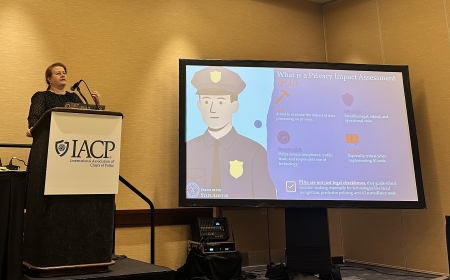The International Association of Chiefs of Police (IACP) Technology Conference 2025 is an annual law enforcement conference that hosts public safety professionals and technology thought leaders to discuss new solutions, techniques and trainings to equip the industry for success. With a strong law enforcement portfolio and deep industry ties, Carahsoft offers unmatched insight into the challenges agencies face today.
By bridging the gap between top software providers and law enforcement agencies, Carahsoft’s Law Enforcement Technology Team helps both sworn and civilian personnel streamline operations, enhance decision-making and drive greater efficiency across all aspects of public safety.
Carahsoft and over 20 of our vendors, including Cellebrite, Zebra, Saferwatch, Blackberry and Magnet Forensics, attended and ran demos of their solutions across data management and analytics, artificial intelligence (AI), emerging technology, forensics, and device security.
Here are the 5 most relevant themes featured at the IACP Technology Conference 2025.

Integrating Artificial Intelligence into Law Enforcement
At IACP Tech, discussions centered around integrating AI into law enforcement to increase efficiency while balancing transparency and accountability to real-time threats. In the panel “Transforming Policing with AI: Efficiency, Accuracy and Ethical Considerations for Report Writing,” panelists underscored how AI can streamline administrative tasks, reduce the time officers spend on documentation and improve the overall accuracy and quality of police reports. Speakers also highlighted that the integration of AI must be accompanied by transparency and accountability. They stressed the importance of clearly disclosing when reports are generated or supported by AI to maintain public trust and uphold ethical standards. In the panel “Curb Your AI Through Privacy Impact Assessments,” speaker Nora Kurzova, the State Auditor of the State of Utah Office, explored the ethical implications that come with predictive AI in law enforcement. Kurzova drew attention to bias present in predictive tools, stressing the importance of human oversight to correct potential biases. With rigorous evaluations of the decisions that automated systems enact, law enforcement can ensure fairness and a positive impact on communities.

Emerging Technologies in Law Enforcement
For modern criminal investigations, law enforcement faces growing complexity in managing and analyzing mass volumes of digital data. As the volume of data generated by connected devices continues to surge, investigators must adapt software that enables timely and efficient data recovery. Critical evidence can come from a variety of sources, such as Nest cameras, smart rings, thermostats and even gaming consoles. Human augmentation technologies, including smart glasses, brain-computer interfaces and mixed reality devices, were all identified as new frontiers that officers could utilize during investigations. By utilizing unconventional data points as corroborative tools and avenues for new leads, law enforcement can increase its investigative awareness.

Breakthroughs in Digital Forensics
At the panel “Advancements in Criminal Investigations: Increasing Solve Rates with Technology,” speaker Ed O’Carroll, a retired Major of the Crimes Bureau from the Fairfax County Police Department, emphasized the transformative impact of advanced investigative technologies in resolving challenging criminal cases. Advancements in digital forensics, genetic genealogy and rapid DNA testing have all transcended the abilities of law enforcement, enabling the solving of difficult cases. As IT continues to evolve, law enforcement can utilize strategic partnerships with technology organizations to improve its digital forensics capabilities and reduce backlogs. With recent technological breakthroughs, skilled crime analysts and forensic professionals can maximize their potential through these revolutionary tools.
The Importance of Interoperable Data in Public Safety
Law enforcement depends on thorough and accurate analytics to improve and maintain capabilities. In the panel “Breaking the Data Chains: Advocating Open and Interoperable Solutions in Public Safety,” speakers explored the evolving role of data in public safety, with a strong emphasis on the importance of interoperability and open standards. Adopting open data standards enables seamless data exchange across systems and jurisdictions. Panelists called for greater vendor transparency and urged public safety agencies to include open data access provisions in their contracts to avoid vendor lock-in. Ultimately, by strengthening data sharing practices, public safety agencies can enhance operational effectiveness and fulfill mission objectives.

Tailored, Interactive Training with Artificial Intelligence
Law enforcement agencies are increasingly utilizing AI and virtual reality technologies to address resource constraints during training. In the panel “How Your Records Management Process Can Work for You—Leveraging RMS Functional Standards,” speaker Jeff Smythe discussed a statewide effort to revise curriculum by embedding AI tools into courses. By synthesizing practical data and automation, law enforcement can improve training and service quality.
Examples of this include:
- Utilizing real-world body camera footage to create simulated scenarios for training
- Collecting best practices to develop AI-powered virtual reality scenarios that feature immediate feedback and debriefing capabilities
- Implementing automated virtual reality scenarios to train soft skills, such as employee counseling and community engagement
By simulating realistic, frequent tech-enhanced training, employers can significantly improve officer readiness and skill retention. AI and virtual tools offer scalable solutions to deliver consistent, high-quality training in an evolving public safety environment.
As law enforcement professionals handle sensitive and vital information, the protection of that information and data is essential to carrying out fair and accurate investigations and procedures. Through tailored training, data analytics and AI, law enforcement can improve capabilities and focus resources on protecting civilians.
To learn more about public safety related technology, visit Carahsoft’s law enforcement portfolio to explore solutions showcased at IACP Technology Conference. For additional research into the key takeaways that industry and Government leaders presented at IACP Technology Conference, view Carahsoft’s full synopsis of key sessions from the tradeshow.

 Addressing these questions and acting on them means committing to fostering a culture of security and secure best practices. There are many technologies that can aid in this endeavor including artificial intelligence (AI) Ops, which assesses system patterns and behaviors to identify and surface anomalies; IAM, which provides an extra layer of authentication through biometrics and contextual authorization; and cloud and virtual environments, which agencies can employ in combination with infrastructure-as-a-service to enhance security.
Addressing these questions and acting on them means committing to fostering a culture of security and secure best practices. There are many technologies that can aid in this endeavor including artificial intelligence (AI) Ops, which assesses system patterns and behaviors to identify and surface anomalies; IAM, which provides an extra layer of authentication through biometrics and contextual authorization; and cloud and virtual environments, which agencies can employ in combination with infrastructure-as-a-service to enhance security. Ransomware: The recent increase of ransomware and impact of successful attacks is driving urgency within law enforcement agencies to institute stronger cybersecurity strategies. Disruptions to police systems cause 911 calls to be rerouted, CAD systems to be disrupted, email and phone systems to be disabled as well as other repercussions. Cybercriminals also threaten to leak confidential informant, victim and officer details if the police do not pay the ransom. Investigations conducted to identify possible ransomware attack patterns revealed that there was no geographic methodology behind the hacks but that the common link was, any vulnerability found in an agency’s system was exploited.
Ransomware: The recent increase of ransomware and impact of successful attacks is driving urgency within law enforcement agencies to institute stronger cybersecurity strategies. Disruptions to police systems cause 911 calls to be rerouted, CAD systems to be disrupted, email and phone systems to be disabled as well as other repercussions. Cybercriminals also threaten to leak confidential informant, victim and officer details if the police do not pay the ransom. Investigations conducted to identify possible ransomware attack patterns revealed that there was no geographic methodology behind the hacks but that the common link was, any vulnerability found in an agency’s system was exploited.